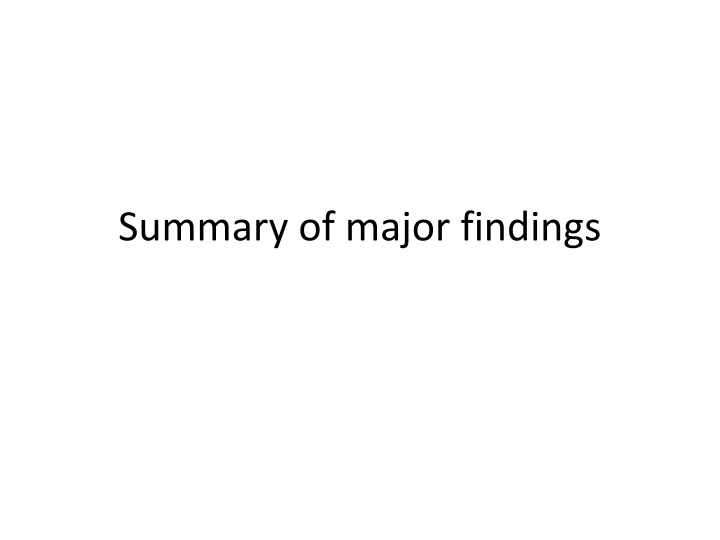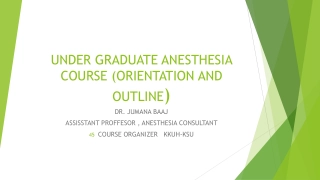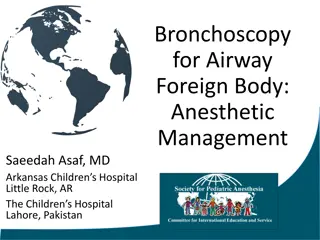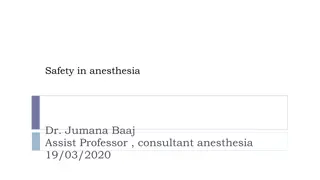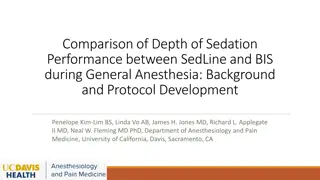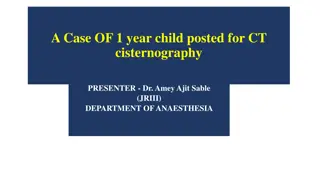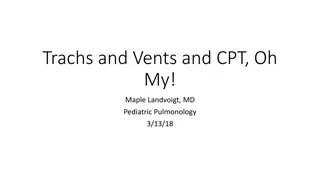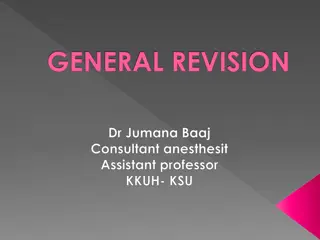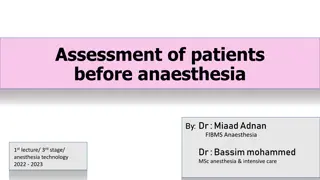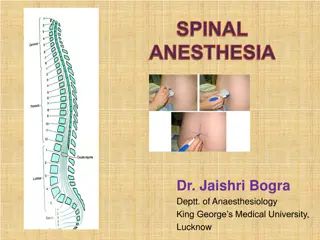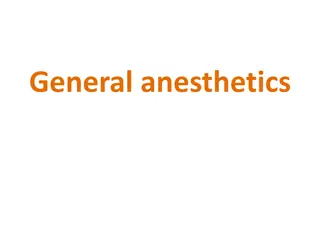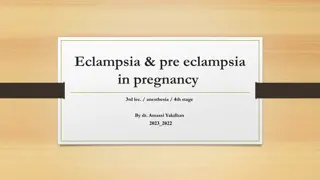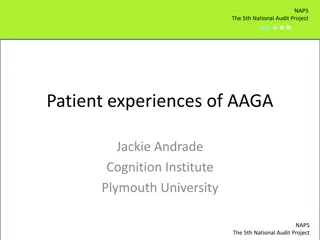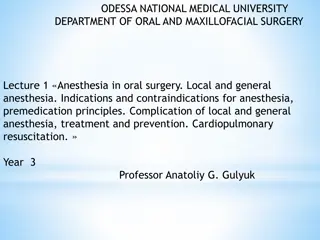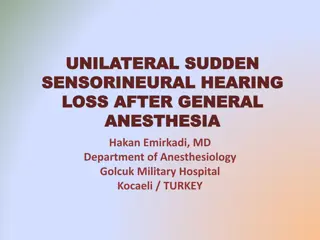Insights on Airway Management in Anesthesia Practices
General anesthesia procedures in the UK NHS involve approximately 2.9 million cases annually, with airway management being a critical aspect. Poor airway assessment and planning, lack of strategies for difficult airways, reluctance to use awake fibreoptic intubation, and inappropriate use of supraglottic airway devices are common challenges. Emphasizing structured assessment, comprehensive planning, and appropriate technique changes can significantly enhance patient safety during anesthesia procedures.
Uploaded on Aug 01, 2024 | 1 Views
Download Presentation

Please find below an Image/Link to download the presentation.
The content on the website is provided AS IS for your information and personal use only. It may not be sold, licensed, or shared on other websites without obtaining consent from the author.If you encounter any issues during the download, it is possible that the publisher has removed the file from their server.
You are allowed to download the files provided on this website for personal or commercial use, subject to the condition that they are used lawfully. All files are the property of their respective owners.
The content on the website is provided AS IS for your information and personal use only. It may not be sold, licensed, or shared on other websites without obtaining consent from the author.
E N D
Presentation Transcript
Approximately 2.9 million general anaesthetics are administered in the UK NHS each year. Airway management 56% SAD 38% TT
Clinical themes Poor airway assessment contributed to poor airway outcomes. omission, incomplete assessment failure to alter the airway management technique in response to findings at assessment. Assessment to predict both potential airway difficulty and aspiration risk were equally important.
Poor planning contributed. When potential difficulty with airway management is identified a strategy is required. An airway plan suggests a single approach to management of the airway. A strategy is a co-ordinated, logical sequence of plans, which aim to achieve good gas exchange and prevention of aspiration.
Failure to plan for failure. When difficulties arose some airway management was unexpectedly difficult the response was un- structured. All anaesthetic departments should have an explicit policy for management of difficult or failed intubation and for impossible mask ventilation and for other airway emergencies. Individual anaesthetists should use such strategies in their daily practice.
Numerous cases where awake fibreoptic intubation (AFOI) was indicated but not used. Cases suggest lack of skills, lack of confidence, poor judgement lack of suitable equipment being immediately available. AFOI should be available and used whenever it is indicated.
Problems arose when difficult intubation was managed by multiple repeat attempts at intubation. Regularly deteriorated to CICV. It is well recognised a change of approach is required rather than repeated use of a technique that has already failed.
SADs were used inappropriately. Non aspiration Patients who were markedly obese, Often managed by junior trainees, Aspiration Numerous cases during use of a first generation SAD In patients who had multiple risk factors Emergencies Juniors
SADs used to avoid tracheal intubation in patients with a recognised difficult intubation. Often no evidence of a back-up plan. If the airway is lost (e.g. due to oedema or mechanical displacement) this becomes an anaesthetic emergency. AFOI or FOI through a SAD before surgery may offer a lower risk alternative.
Head and neck surgery featured frequently in cases reported to NAP4. These cases require careful assessment and co- ordinated planning by skilled anaesthetists and surgeons. Excellent teamwork is required as when any part of this process fails the risk of adverse outcomes is high.
Management of the obstructed airway requires particular skill and co-operation between anaesthetist and surgeon. This is best performed in a fully equipped environment with full surgical, anaesthetic and nursing support. An operating theatre is the ideal location. Tracheostomy under LA should be actively considered. When surgical airway performed by a surgeon is the back-up plan preparation should be made so this is can be instantly available.
Complications in obese patients were twice that in the general population, this finding was even more evident in the morbidly obese. Ignored as risk factor particular complications aspiration SAD complications difficulty at tracheal intubation airway obstruction during emergence or recovery. Failure of rescue techniques Obesity needs to be recognised as a risk factor for airway difficulty and plans modified accordingly.
High failure rate of emergency cannula cricothyroidotomy (60%) numerous mechanisms root cause not determined; The technique of cannula cricothyroidotomy needs to be taught and performed to the highest standards to maximise the chances of success. The possibility exists that it is intrinsically inferior to a surgical technique
Aspiration was the single commonest cause of death in anaesthesia events. Poor judgement poor assessment of risk (patient and operation) failure to use airway devices or techniques that would offer increased protection against aspiration. Several major events occurred when there were clear indications for a RSI but this was not performed.
Failure to correctly interpret a capnograph trace led to several oesophageal intubations going unrecognised in anaesthesia. A flat capnograph trace indicates lack of ventilation of the lungs: the tube is either not in the trachea or the airway is completely obstructed. Active efforts should be taken to positively exclude these diagnoses. This applies equally in cardiac arrest as CPR leads to an attenuated but visible expired carbon dioxide trace.
One third of events occurred during emergence or recovery obstruction was the common cause POPO was described in 1 in 10 reports. This phase of anaesthesia, particularly when the airway was difficult at intubation or there is blood in the airway, needs to be recognised as a period of increased risk and planed for.
In more than a third of events from all sources; during anaesthesia, in ICU and the emergency department, airway management was judged to be poor. More often there were elements of both good and poor management. In approximately one fifth of cases airway management was judged to be exclusively good.
ICU and the emergency department At least one in four major airway events reported to NAP4 was from ICU or the emergency department. Outcome was more adverse than events in anaesthesia. Gaps in care that included: poor identification of at-risk patients poor or incomplete planning inadequate provision of skilled staff and equipment to delayed recognition of events failed rescue lack of or failure of interpretation of capnography. Avoidable deaths due to airway complications occur in ICU and the emergency department.
Failure to use capnography in ventilated patients likely contributed to more than 70% of ICU related deaths. Increasing use of capnography on ICU is the single change with the greatest potential to prevent deaths such as those reported to NAP4.
Displaced tracheostomy, and to a lesser extent displaced tracheal tubes, were the greatest cause of major morbidity and mortality in ICU. Obese patients were at particular risk. All patients on ICU should have an emergency re- intubation plan.
Most events in the emergency department were complications of rapid sequence induction. This was also an area of concern in ICU. RSI outside the operating theatre requires the same level of equipment and support as is needed during anaesthesia. This includes capnography and access for equipment needed to manage routine and difficult airway problems.
Airway management is a fundamental anaesthetic responsibility and skill Anaesthetic departments should provide leadership in developing strategies to deal with difficult airways throughout the entire organisation.
Interpretation of results Many of the events and deaths reported to NAP4 were likely avoidable. Despite this finding, the incidence of serious complications associated with anaesthesia is low. This is also true for airway management in ICU and the emergency department, though it is likely that a disproportionate number of airway events occur in these locations. The aim of this report is that detailed attention to its contents and compliance with the recommendations will make it safer.
Interpretation of results Many of the findings of NAP4 are neither surprising nor new. The breadth of the project, covering the whole of the UK for a full year, is. NAP4 should provide impetus to changes that can further improve the safety of airway management in the UK in anaesthesia intensive care and the emergency department. Our goal should be to reduce serious complications of airway management to zero.
websites BJA full papers http://bja.oxfordjournals.org/content/early/2011/ 03/25/bja.aer058.full.pdf+html http://bja.oxfordjournals.org/content/early/2011/ 03/25/bja.aer059.full.pdf+html RCoA full report http://www.rcoa.ac.uk/index.asp?PageID=1089
